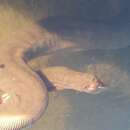mk
имиња во трошки


No information is available.
IUCN Red List of Threatened Species: least concern
File snakes continue to be important food for Aboriginal communities in northern Australia. Aboriginal people, usually the elder women, still hunt for File snakes by wading into the water and feeling under submerged logs and overhanging banks. Once captured, the snakes are usually tossed onto the bank where they are easily collected due to their extremely slow movement on land. Pregnant females are very valuable to the Aboriginal people. The oviducts of reproductive females contain large, yolk-filled embryos in November, and these are considered a special treat to the Aboriginies. Most snakes are kept for a few days in large empty pots then tossed into a fire to cook (Shine, 1991).
File snakes feed almost exclusively on fish. They move slowly at night, poking their heads in and out of holes in mangroves and riverbanks. Prey selection depends on the size of the snake, with larger specimens ingesting fish up to 1 kilogram in weight. These snakes have extremely low metabolic rates, due to their slow, but deliberate style of hunting, and consequently feed less (about once a month) than most snakes. File snakes possess small, solid teeth, and catch their prey using their mouth, body coils, and tail. It is thought that the small granular scales of File snakes contain sensory organs that are probably used in movement, orientation, and prey sensing (Shine, 1991).
The File snake inhabits the coastal regions of northern Australia and also New Guinea (Hoser, 1989).
Biogeographic Regions: australian (Native )
File snakes are nocturnal as well as aquatic; and very seasonal when choosing their preferred habitat. In the dry season, snakes choose backwater lagoons and pools known locally as billabongs. Upon arrival of the wet season, File snakes migrate into flooded grasslands and mangroves (Shine, 1991). These unusually docile snakes can be found resting in aquatic vegetation or in tree roots by day, and hunting among banks or channels by night. File snakes can spend lengthy amounts of time underwater, and surface only to restock their oxygen supply. Radio telemetry studies have shown that File snakes are capable of moving considerable distances during the night, and average 140 meters a night during the wet season and 70 meters a night during the dry season (Vincent, 1999).
Aquatic Biomes: lakes and ponds; rivers and streams; coastal
Average lifespan
Status: captivity: 8.8 years.
Acrochordus arafurae is non-venomous and reaches a maximum length of 2.5 meters, with 1.5 meters being the average length. They are sexually dimorophic with females generally the larger sex. File snakes are aquatic snakes with small, but very strongly keeled scales, which give them the texture of a file. The skin of file snakes is very loose and baggy. Colors vary slightly, but most are light brown or gray with dark brown or black reticulations extending from a broad vertebral band that gives a cross-banded, or a blotchy appearance on the dorsal surface of the body. File snakes are somewhat lighter underneath, and the dark reticulations usually extend onto the ventral surface of the body (Vincent, 1999).
File snakes are viviparous and give birth to between 6 and 27 young, which usually average about 36 centimeters SVL. Sexual maturity is reached by males at about 85 centimeters SVL, and at about 115 centimeters SVL in females. File snakes do not reproduce each year. In fact, it's believed that females reproduce only every eight to ten years in the wild. High population density, low metabolic rates, and poor feeding efficiency are thought to be possible causes for such low repreductive rates. Males are also able to store sperm in their bodies for a number of years (Vincent, 1999).